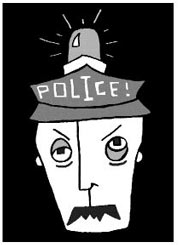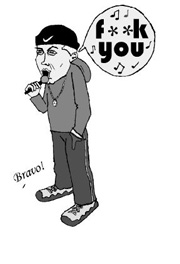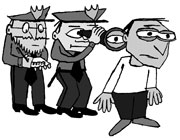FOR SOME REASON, especially in recent months, there has been a sea of change in how the Seattle Police Department handles crowds of people—particularly young people, particularly young people with an attitude about authority. It’s a change that apparently plays well with merchants and much of the public, but it plays havoc not only with basic civil rights but also with public safety and common sense.
For those who missed the most recent example: For the last several years, the usual mixture of Capitol Hill freaks and celebrants have taken to an impromptu parade on New Year’s Eve, of a sort not uncommon that night in every large city on Earth—to wit, raucous, drunken silliness that, in the end, hurts nobody. This year, Seattle writer and activist Tara Herivel reports, a couple hundred people with costumes, drums, noisemakers, and whatnot headed up Pine, stalked by a small army of bike cops, cops in riot gear, cops in cars, vans, buses, and helicopters. All it took was a couple of firecrackers and what one eyewitness calls “a very lame attempt at a bonfire,” and the police smoke bombs and crowd-clearing tactics were on.
This is rapidly becoming its own ugly, unnecessary tradition. In 25 years of such things, never in my life have I gotten shoved around and knocked down by cops at a political event as much as I did six weeks ago—as a clearly marked impartial media observer—during this year’s protest marking the anniversary of the shutdown of the World Trade Organization meetings in Seattle. I was struck, at the time, by how intently the police seemed to want to provoke the crowd. And I was especially thankful that the protesters weren’t the types to handle or use firearms, because if they had been, someone would have gotten shot. There was that much rage in the air. The lack of a riot was in spite of, not because of, the police.
The irony was that nearly the exact same parties—same organizers, same participants, same issue, same places, even the same time and day of the week—had gathered three weeks previously to hold essentially the same march and rally, and the police used a few bicycle and traffic cops to keep a watchful eye. That was it. And nothing happened. The use of force during the WTO anniversary march—as on New Year’s Eve, when firecrackers were going off all over the city—was completely arbitrary, intended to make A Statement. That statement, roughly translated: “We’re the Seattle Police Department, and we’re above the law.”
As satisfying as that might be for some officers and some city officials, it’s crappy policing. It’s hard not to notice that the only two times there has been property damage recently during a political protest—at 1999’s WTO protest and last August’s “Reclaim the Streets” protest—it came only after police attacked the crowd. For many years—before the Gulf War, up through WTO, and in many cases even since then—the police have handled hundreds of these street protests a year in a very sensible way: Officers identify and talk with activist leaders or spokespeople and find out their plans; they let the group use the sidewalk, half the street, or the full street (depending on the crowd’s size); and then they stop traffic and use a handful of bicycle cops to keep a watchful eye. And half an hour later, everyone goes home happy.
Instead, New Year’s Eve marked, by my count, at least the sixth use of “less than lethal munitions” by police on a protest crowd in the last two years. There is the matter of selective enforcement, of course: People who look or dress a certain way or have particular politics have far fewer rights to speech or assembly now in Seattle than the rest of us, regardless of what they do or don’t do, or even what they’ve done in the past. And plenty of other people are effectively denied their right to political speech because they’re afraid to attend (let alone bring their children) or the protest is never organized in the first place. It’s hard to get your message out if every protest is about free-speech rights.
Beyond that niggling detail, the cops’ macho posturing is extremely dangerous. There are now hundreds of young people in this city who go to a protest expecting war. Some of them fear it and pray that the police will be on their meds that day; others look forward to it, attracted by the adrenaline rush of a “good” street fight and targets for their hate. Sooner or later, unless the police department returns to its senses, not only will we have lost some very basic rights in this city, but someone is going to get hurt—or killed.







